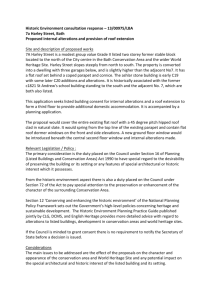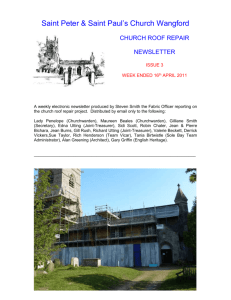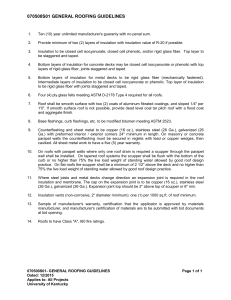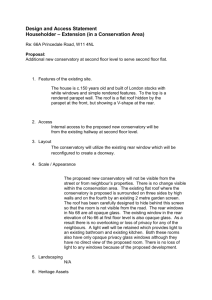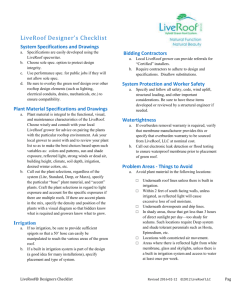CONSTRUCTION WORKPLACE DESIGN SOLUTION
advertisement
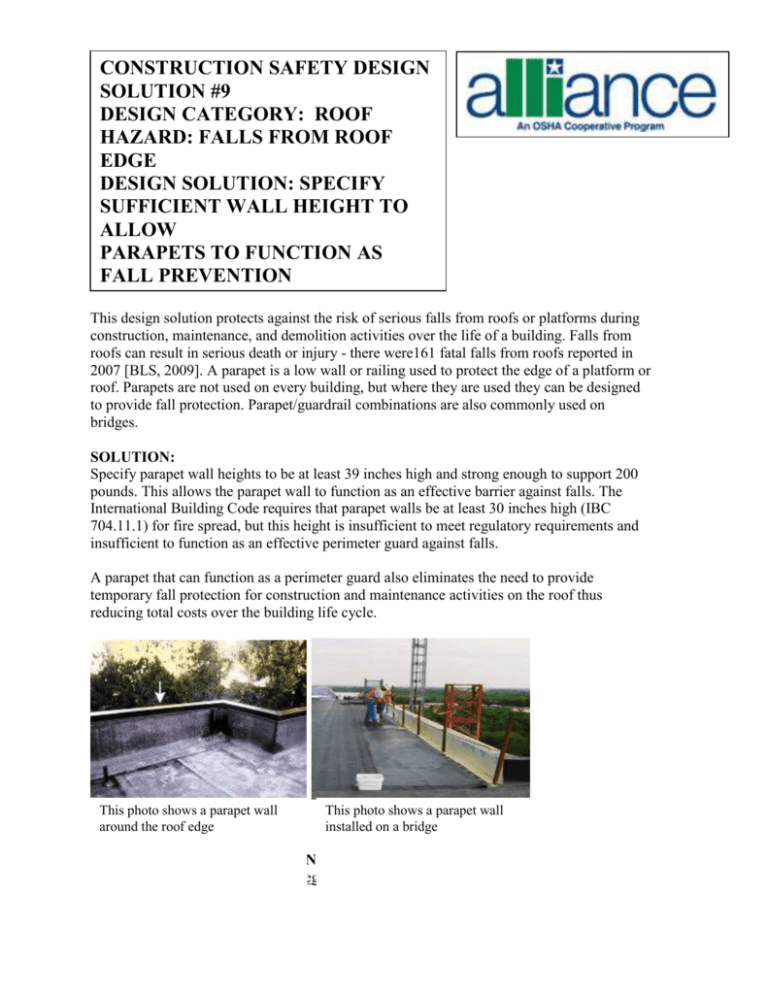
CONSTRUCTION SAFETY DESIGN SOLUTION #9 DESIGN CATEGORY: ROOF HAZARD: FALLS FROM ROOF EDGE DESIGN SOLUTION: SPECIFY SUFFICIENT WALL HEIGHT TO ALLOW PARAPETS TO FUNCTION AS FALL PREVENTION HAZARD: FALLS This design solution protects against the risk of serious falls from roofs or platforms during construction, maintenance, and demolition activities over the life of a building. Falls from roofs can result in serious death or injury - there were161 fatal falls from roofs reported in 2007 [BLS, 2009]. A parapet is a low wall or railing used to protect the edge of a platform or roof. Parapets are not used on every building, but where they are used they can be designed to provide fall protection. Parapet/guardrail combinations are also commonly used on bridges. SOLUTION: Specify parapet wall heights to be at least 39 inches high and strong enough to support 200 pounds. This allows the parapet wall to function as an effective barrier against falls. The International Building Code requires that parapet walls be at least 30 inches high (IBC 704.11.1) for fire spread, but this height is insufficient to meet regulatory requirements and insufficient to function as an effective perimeter guard against falls. A parapet that can function as a perimeter guard also eliminates the need to provide temporary fall protection for construction and maintenance activities on the roof thus reducing total costs over the building life cycle. This photo shows a parapet wall around the roof edge This photo shows a parapet wall installed on a bridge BACKGROUND INFORMATION Applicable US Safety and Health Regulations OSHA Construction standards 1926.501(b)(1) “Unprotected sides and edges.” Each employee on a walking/working surface (horizontal and vertical surface) with an unprotected side or edge which is 6 feet (1.8 m) or more above a lower level shall be protected from falling by the use of guardrail systems, safety net systems, or personal fall arrest systems. Unprotected sides and edges is defined as meaning any side or edge (except at entrances to points of access) of a walking/working surface, e.g., floor, roof, ramp, or runway where there is no wall or guardrail system at least 39 inches (1.0 m) high. Other information Various local building codes may address parapet design and height. For example, since 1968 buildings in New York City more than twenty-two feet in height with roofs flatter than twenty degrees have been required to be provided with a parapet not less than three feet six inches (42 inches) high, or be provided with a 42 inch railing or fence, or combination [§[C26-503.4] 27-334 Protective guards]. Various state codes may also address guardrail and parapet heights for highway bridges. For example, the Texas Department of Transportation specifies a 42 inch guardrail (24 inch parapet with 18 inch guardrail) for bridge railings for pedestrians [Manual Notice 2006-1, Section 5] AVAILABLE EXAMPLES OF PRODUCT OR USE: No specific parapet products were found as they are commonly constructed as part of the building. There may be combination parapet and guardrail products available for bridges. OTHER CONSIDERATIONS Parapet design must also consider other potential uses. For example, some parapets may be designed to support window-washing scaffolds or for use as an anchorage with personal fall arrest systems. Parapets must be maintained over the life of the building. Older parapets may need bracing. A parapet wall may change the snow or pond loading on a roof. The designer should take this into account when considering a parapet roof as additional structural framing may be required. LIFE CYCLE SOLUTION BENEFITS A parapet can also eliminates the need to provide temporary fall protection during maintenance activities on the roof thus reducing total costs over the building life cycle. A parapet roof can also be an important feature when considering garden roofs. ADDITIONAL INFORMATION SOURCES BLS, 2009. Table 1. Fatal occupational injuries by event or exposure, 2006-2007: http://stats.bls.gov/news.release/cfoi.t01.htm NIOSH, 1991. University Employee is Fatally Injured in 120-foot Fall from Roof: http://www.cdc.gov/niosh/face/stateface/co/91co020.html NIOSH, 1993. Roofing Estimator Dies After Falling 14 Feet From The Roof of a Shopping Center Strip Mall: http://www.cdc.gov/niosh/face/stateface/nj/93nj094.html NYC Title 27 Administrative Code Construction and Maintenance §[C26-503.4] 27-334 Protective guards, 2004: http://www.nyc.gov/html/dob/downloads/bldgs_code/bc27s5.pdf#page=5 Texas Department of Transportation Manual Notice 2006-1, Section 5, 2006: http://onlinemanuals.txdot.gov/txdotmanuals/rlg/bridge_railing_for_pedestrians.htm#CH DEHHBF at http://onlinemanuals.txdot.gov/txdotmanuals/rlg/metal_and_concrete_railing.htm Through the OSHA Alliance Program’s Construction Roundtable, the Roundtable participants developed this product for informational purposes only. It does not necessarily reflect the official views of OSHA or the U.S. Department of Labor.
